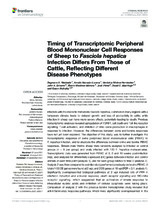Mostrar el registro sencillo del ítem
Timing of Transcriptomic Peripheral Blood Mononuclear Cell Responses of Sheep to Fasciola hepatica Infection Differs From Those of Cattle, Reflecting Different Disease Phenotypes
| dc.contributor.author | Niedziela, Dagmara A. | |
| dc.contributor.author | Naranjo-Lucena, Amalia | |
| dc.contributor.author | Molina-Hernández, Verónica | |
| dc.contributor.author | Browne, J.A. | |
| dc.contributor.author | Martínez Moreno, Álvaro | |
| dc.contributor.author | Pérez, José | |
| dc.contributor.author | MacHugh, David E. | |
| dc.contributor.author | Mulcahy, Grace | |
| dc.date.accessioned | 2024-02-08T18:54:33Z | |
| dc.date.available | 2024-02-08T18:54:33Z | |
| dc.date.issued | 2021 | |
| dc.identifier.uri | http://hdl.handle.net/10396/27322 | |
| dc.description.abstract | Infection with the zoonotic trematode Fasciola hepatica, common in many regions with a temperate climate, leads to delayed growth and loss of productivity in cattle, while infection in sheep can have more severe effects, potentially leading to death. Previous transcriptomic analyses revealed upregulation of TGFB1, cell death and Toll-like receptor signalling, T-cell activation, and inhibition of nitric oxide production in macrophages in response to infection. However, the differences between ovine and bovine responses have not yet been explored. The objective of this study was to further investigate the transcriptomic response of ovine peripheral blood mononuclear cells (PBMC) to F. hepatica infection, and to elucidate the differences between ovine and bovine PBMC responses. Sixteen male Merino sheep were randomly assigned to infected or control groups (n = 8 per group) and orally infected with 120 F. hepatica metacercariae. Transcriptomic data was generated from PBMC at 0, 2 and 16 weeks post-infection (wpi), and analysed for differentially expressed (DE) genes between infected and control animals at each time point (analysis 1), and for each group relative to time 0 (analysis 2). Analysis 2 was then compared to a similar study performed previously on bovine PBMC. A total of 453 DE genes were found at 2 wpi, and 2 DE genes at 16 wpi (FDR < 0.1, analysis 1). Significantly overrepresented biological pathways at 2 wpi included role of PKR in interferon induction and anti-viral response, death receptor signalling and RIG-I-like receptor signalling, which suggested that an activation of innate response to intracellular nucleic acids and inhibition of cellular apoptosis were taking place. Comparison of analysis 2 with the previous bovine transcriptomic study revealed that anti-inflammatory response pathways which were significantly overrepresented in the acute phase in cattle, including IL-10 signalling, Th2 pathway, and Th1 and Th2 activation were upregulated only in the chronic phase in sheep. We propose that the earlier activation of anti-inflammatory responses in cattle, as compared with sheep, may be related to the general absence of acute clinical signs in cattle. These findings offer scope for "smart vaccination" strategies for this important livestock parasite. | es_ES |
| dc.format.mimetype | application/pdf | es_ES |
| dc.language.iso | eng | es_ES |
| dc.publisher | Frontiers | es_ES |
| dc.rights | https://creativecommons.org/licenses/by/4.0/ | es_ES |
| dc.source | Niedziela DA, Naranjo-Lucena A, Molina-Herna´ ndez V, Browne JA, Mart´ınez-Moreno A´, Pe´rez J, MacHugh DE and Mulcahy G (2021) Timing of Transcriptomic Peripheral Blood Mononuclear Cell Responses of Sheep to Fasciola hepatica Infection Differs From Those of Cattle, Reflecting Different Disease Phenotypes. Front. Immunol. 12:729217. doi: 10.3389/fimmu.2021.729217 | es_ES |
| dc.subject | Fasciola | es_ES |
| dc.subject | PBMC | es_ES |
| dc.subject | Anti-inflammatory response | es_ES |
| dc.subject | Sheep | es_ES |
| dc.subject | Transcriptomics | es_ES |
| dc.title | Timing of Transcriptomic Peripheral Blood Mononuclear Cell Responses of Sheep to Fasciola hepatica Infection Differs From Those of Cattle, Reflecting Different Disease Phenotypes | es_ES |
| dc.type | info:eu-repo/semantics/article | es_ES |
| dc.relation.publisherversion | https://doi.org/10.3389/fimmu.2021.729217 | es_ES |
| dc.relation.projectID | info:eu-repo/grantAgreement/EC/H2020/635408 (PARAGONE) | es_ES |
| dc.rights.accessRights | info:eu-repo/semantics/openAccess | es_ES |

